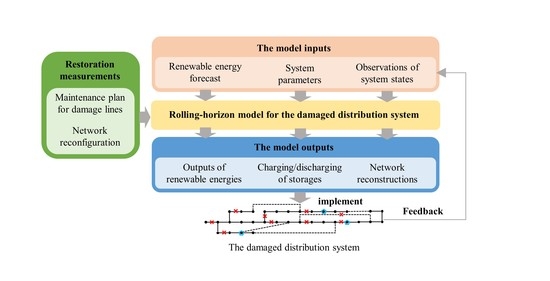A Rolling Horizon Optimization Framework for Resilient Restoration of Active Distribution Systems
Abstract
:1. Introduction
- An ADN consists of more than one type of power source which can serve as an emergency backup generator. The restoration problem considering network reconfiguration still needs to be modeled in more detail.
- The multiperiod restoration problem needs lots of predictions, which introducing prediction errors into the model. Additionally, the existence of a large number of integral variables will limit its application.
- We establish a detailed multiperiod resilient network reconfiguration model, which considers different power supply sources (including DERs). The impacts of network changes on power flow and voltage are fully studied. In addition, some linearization techniques are adopted to reduce the complexity of the model.
- We develop a rolling-horizon-optimization-based framework for this multiperiod problem in order to make effective use of predictions and speed up the model computation. This method can reliably solve the reconfiguration problem.
2. Multiperiod Network Restoration of Distribution Systems
2.1. Preliminaries
2.2. Radiality Constraints
2.3. Power Flow Constraints
2.3.1. Power Balance
2.3.2. Voltage Constraints
2.3.3. Power Outputs
- Feeders: The feeders are the main source of power supply. For each nodes connecting to the main grid, we have the following constraints:where is the set of feeders. and are the lower and upper bound of the active power supply at the feeder, respectively; and are the lower and upper bound of the reactive power supply at the feeder, respectively. and can be positive or negative.
- DER outputs: With the development of DERs, different forms of energies, such as wind and solar, are integrated into the ADNs. In the post-event restoration, these types of DERs can realize an emergency power supply through equipped smart inverters. Their output ranges are:where is the set of nodes equipped with DERs. In this work, we focus on renewable energies. Their output ranges can be obtained with accurate predictions.It is noted that the damaged ADN in our work is separated into several islanded MGs to realize an emergency power supply with DERs and storage. Under this circumstance, the DERs should be operated in a Volt-Var (QV) response mode since the islanded MGs lack reactive power support. The DERs operating in QV mode can maintain the voltage and distribution of active power by outputting reactive power. As line repair progresses, DERs can switch their control strategy since the islanded MGs are reconnected to the main grid. The system can obtain the reactive power from the grid. Thus, DERs could choose strategies such as “Maximum Power Point Tracking”, etc., to output more active power.
- ESS outputs: The ESS can keep the ADN in balance. Considering the process of charging and discharging, we have the following constraints for the nodes () equipped with ESS:where is the set of nodes equipped with ESS; is the power discharged from the ESS to the ADN; is the power that the ESS can charge from the ADN. The difference between and calculated in Constraint (22) determines the power that the ESS feeds into the system.
- Pure load nodes: As for pure load nodes, they cannot feed power back to the grid. Hence, we set and as:
2.3.4. Power Load Model
- and specify the constant impedance for active and reactive power demands on bus i.
- and specify the constant current for active and reactive power demands on bus i.
- and specify the constant power for active and reactive power demands on bus i.
2.3.5. Ess Operation
2.4. Linearization Technique
2.5. Multiperiod Reconfiguration Model
- Objective function: (34)
3. Rolling Horizon Optimization Framework for Resilient Restoration
3.1. Basics of Rolling Horizon Optimization
3.2. Steps of Solving Restoration Strategy with Proposed Methods
- Step 1: Update predictions of user’s load, DER outputs from t to ; update SOC of storage and the line states with line maintenance plan over 0 to .
- Step 2: Solve the optimization problem established in Section 2.5 with updated predictions.
- Step 3: Apply the solved operation strategy at period t; record the system states at the beginning of period .
4. Case Study
4.1. System Parameters
4.1.1. System Configurations
4.1.2. Predictions of Loads and DER Outputs
4.2. Restoration Effect
4.2.1. The Process of Network Reconfiguration
4.2.2. Restoration Effect of Proposed Method
4.2.3. Role of Energy Storage in Recovery
4.3. Analysis of Linearization
4.3.1. Linearization of Power Flow Conversation Constraints
4.3.2. Linearization of Line Capacity Constraints
5. Conclusions
Author Contributions
Funding
Institutional Review Board Statement
Informed Consent Statement
Data Availability Statement
Conflicts of Interest
References
- Lasseter, R.; Akhil, A.; Marnay, C.; Stephens, J.; Dagle, J.; Guttromsom, R.; Meliopoulous, A.S.; Yinger, R.; Eto, J. Integration of Distributed Energy Resources. The CERTS Microgrid Concept; Technical Report; Lawrence Berkeley National Lab. (LBNL): Berkeley, CA, USA, 2002. [Google Scholar]
- Peponis, G.; Papadopoulos, M.; Hatziargyriou, N. Distribution network reconfiguration to minimize resistive line losses. IEEE Trans. Power Deliv. 1995, 10, 1338–1342. [Google Scholar] [CrossRef]
- Dorostkar-Ghamsari, M.R.; Fotuhi-Firuzabad, M.; Lehtonen, M.; Safdarian, A. Value of distribution network reconfiguration in presence of renewable energy resources. IEEE Trans. Power Syst. 2015, 31, 1879–1888. [Google Scholar] [CrossRef]
- Zhu, D.; Cheng, D.; Broadwater, R.P.; Scirbona, C. Storm modeling for prediction of power distribution system outages. Electr. Power Syst. Res. 2007, 77, 973–979. [Google Scholar] [CrossRef]
- Rao, R.S.; Ravindra, K.; Satish, K.; Narasimham, S. Power loss minimization in distribution system using network reconfiguration in the presence of distributed generation. IEEE Trans. Power Syst. 2012, 28, 317–325. [Google Scholar] [CrossRef]
- Han, S.R. Estimating Hurricane Outage and Damage Risk in Power Distribution Systems; Texas A&M University: College Station, TX, USA, 2008. [Google Scholar]
- Chen, C.; Wang, J.; Qiu, F.; Zhao, D. Resilient distribution system by microgrids formation after natural disasters. IEEE Trans. Smart Grid 2016, 7, 958–966. [Google Scholar] [CrossRef]
- Ding, T.; Lin, Y.; Bie, Z.; Chen, C. A resilient microgrid formation strategy for load restoration considering master-slave distributed generators and topology reconfiguration. Appl. Energy 2017, 199, 205–216. [Google Scholar] [CrossRef]
- Lee, C.; Liu, C.; Mehrotra, S.; Bie, Z. Robust distribution network reconfiguration. IEEE Trans. Smart Grid 2014, 6, 836–842. [Google Scholar] [CrossRef]
- Ma, S.; Chen, B.; Wang, Z. Resilience enhancement strategy for distribution systems under extreme weather events. IEEE Trans. Smart Grid 2018, 9, 1442–1451. [Google Scholar] [CrossRef]
- Lei, S.; Hou, Y.; Qiu, F.; Yan, J. Identification of critical switches for integrating renewable distributed generation by dynamic network reconfiguration. IEEE Trans. Sustain. Energy 2017, 9, 420–432. [Google Scholar] [CrossRef]
- Wu, T.; Wang, J.; Lu, X.; Du, Y. AC/DC hybrid distribution network reconfiguration with microgrid formation using multi-agent soft actor-critic. Appl. Energy 2022, 307, 118189. [Google Scholar] [CrossRef]
- Li, B.; Chen, Y.; Wei, W.; Huang, S.; Mei, S. Resilient Restoration of Distribution Systems in Coordination with Electric Bus Scheduling. IEEE Trans. Smart Grid 2021, 12, 3314–3325. [Google Scholar] [CrossRef]
- Nikkhah, S.; Jalilpoor, K.; Kianmehr, E.; Gharehpetian, G.B. Optimal wind turbine allocation and network reconfiguration for enhancing resiliency of system after major faults caused by natural disaster considering uncertainty. IET Renew. Power Gener. 2018, 12, 1413–1423. [Google Scholar] [CrossRef]
- Hamid-Oudjana, S.; Mosbah, M.; Zine, R.; Arif, S. Optimum Dynamic Network Reconfiguration in Smart Grid Considering Photovoltaic Source. In Proceedings of the International Conference in Artificial Intelligence in Renewable Energetic Systems, Taghit, Bechar, Algeria, 24–26 November 2019; pp. 557–565. [Google Scholar]
- Jiang, L.; Chen, W.; Chen, Y.; Lai, J.; Yin, X. Resilient Control Strategy Based on Power Router for Distribution Network with Renewable Generation. In Proceedings of the 10th Renewable Power Generation Conference (RPG 2021), Online, 14–15 October 2021. [Google Scholar]
- Lei, S.; Chen, C.; Li, Y.; Hou, Y. Resilient Disaster Recovery Logistics of Distribution Systems: Co-Optimize Service Restoration with Repair Crew and Mobile Power Source Dispatch. IEEE Trans. Smart Grid 2019, 10, 6187–6202. [Google Scholar] [CrossRef] [Green Version]
- Yang, Z.; Dehghanian, P.; Nazemi, M. Enhancing seismic resilience of electric power distribution systems with mobile power sources. In Proceedings of the 2019 IEEE Industry Applications Society Annual Meeting, Baltimore, MD, USA, 29 September–3 October 2019; pp. 1–7. [Google Scholar]
- Kianmehr, E.; Nikkhah, S.; Vahidinasab, V.; Giaouris, D.; Taylor, P.C. A resilience-based architecture for joint distributed energy resources allocation and hourly network reconfiguration. IEEE Trans. Ind. Inform. 2019, 15, 5444–5455. [Google Scholar] [CrossRef]
- Li, B.; Chen, Y.; Wei, W.; Mei, S.; Hou, Y.; Shi, S. Preallocation of Electric Buses for Resilient Restoration of Distribution Network: A Data-Driven Robust Stochastic Optimization Method. IEEE Syst. J. 2021, 1–12. [Google Scholar] [CrossRef]
- Li, B.; Chen, Y.; Wei, W.; Huang, S.; Xiong, Y.; Mei, S.; Hou, Y. Routing and Scheduling of Electric Buses for Resilient Restoration of Distribution System. IEEE Trans. Transp. Electrif. 2021, 7, 2414–2428. [Google Scholar] [CrossRef]
- Elsayed, W.T.; Farag, H.; Zeineldin, H.H.; El-Saadany, E.F. Formation of Islanded Droop-Based Microgrids with Optimum Loadability. IEEE Trans. Power Syst. 2021, 37, 1564–1576. [Google Scholar] [CrossRef]
- Low, S.H. Convex relaxation of optimal power flow—Part I: Formulations and equivalence. IEEE Trans. Control. Netw. Syst. 2014, 1, 15–27. [Google Scholar] [CrossRef] [Green Version]
- Sethi, S.; Sorger, G. A theory of rolling horizon decision making. Ann. Oper. Res. 1991, 29, 387–415. [Google Scholar] [CrossRef]
- Li, B.; Chen, Y.; Wei, W.; Wang, Z.; Mei, S. Online Coordination of LNG Tube Trailer Dispatch and Resilience Restoration of Integrated Power-Gas Distribution Systems. IEEE Trans. Smart Grid 2022, 13, 1938–1951. [Google Scholar] [CrossRef]
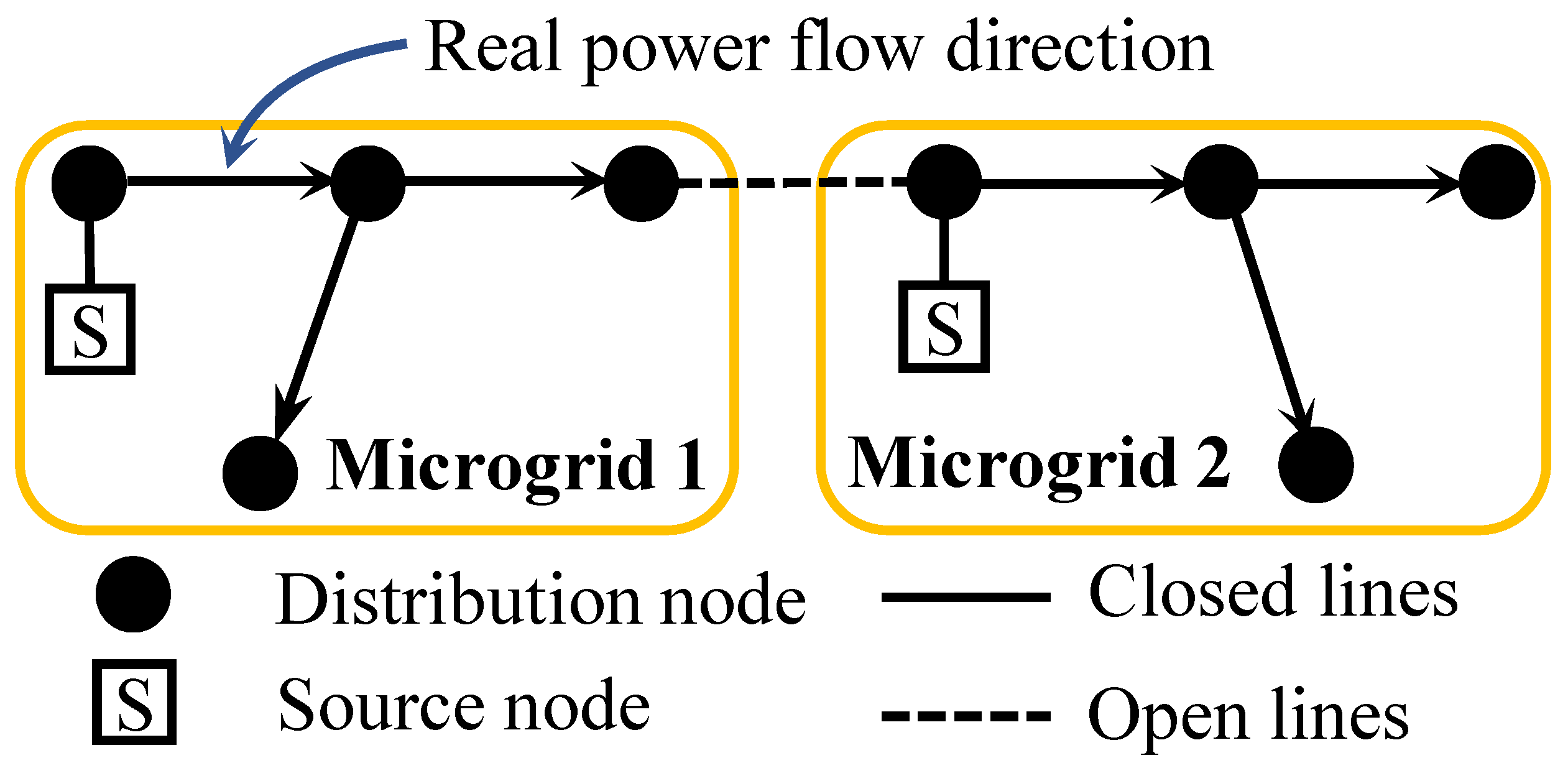

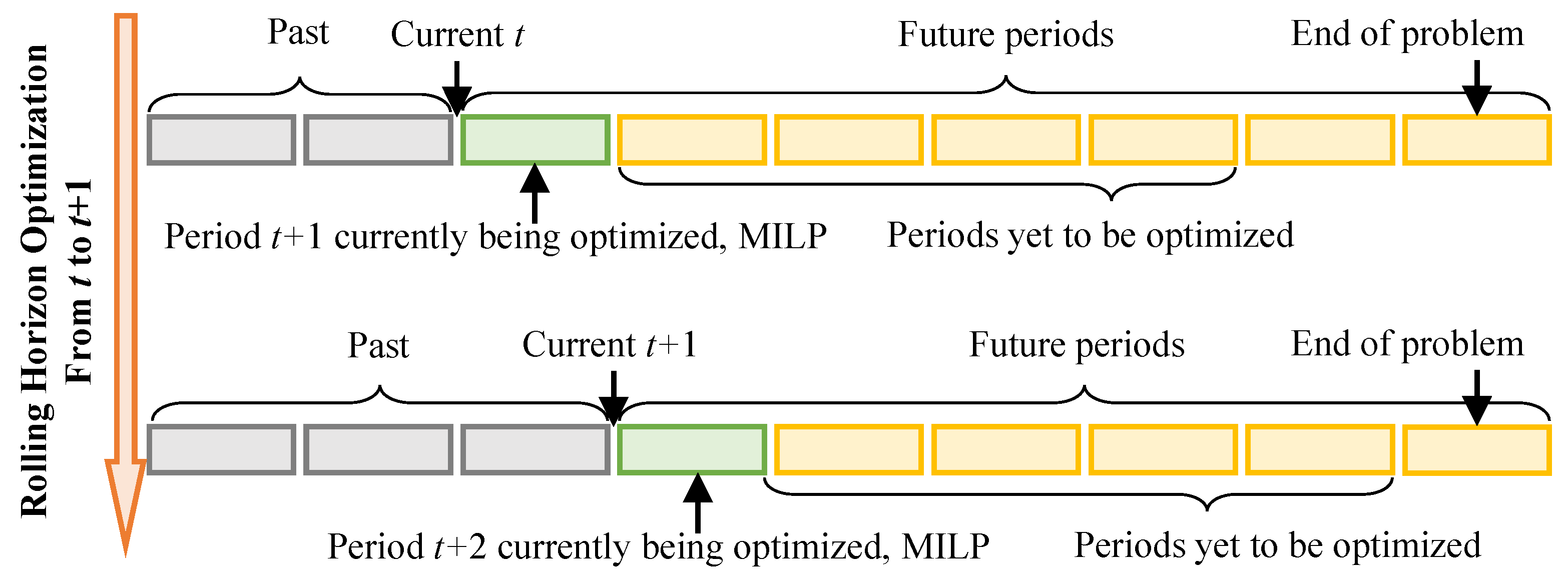


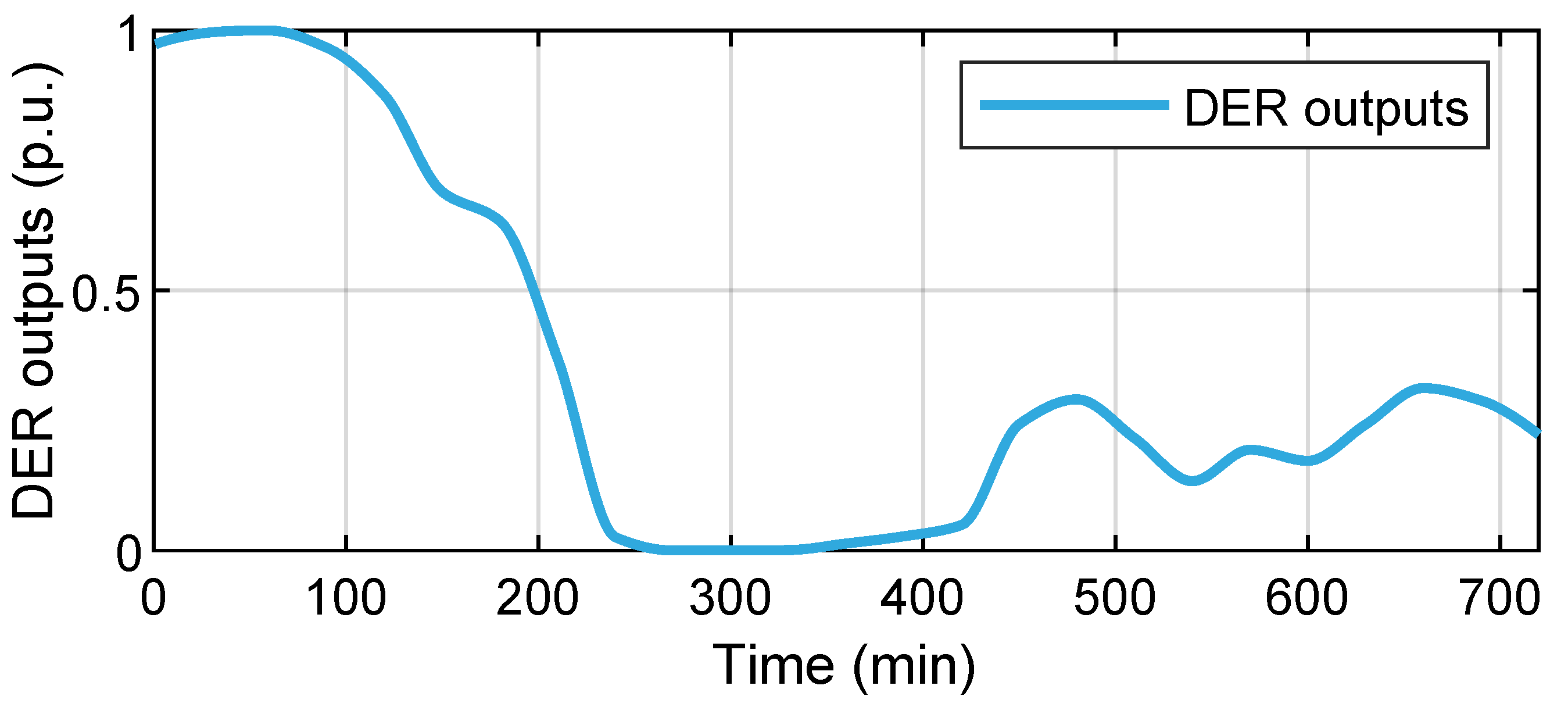
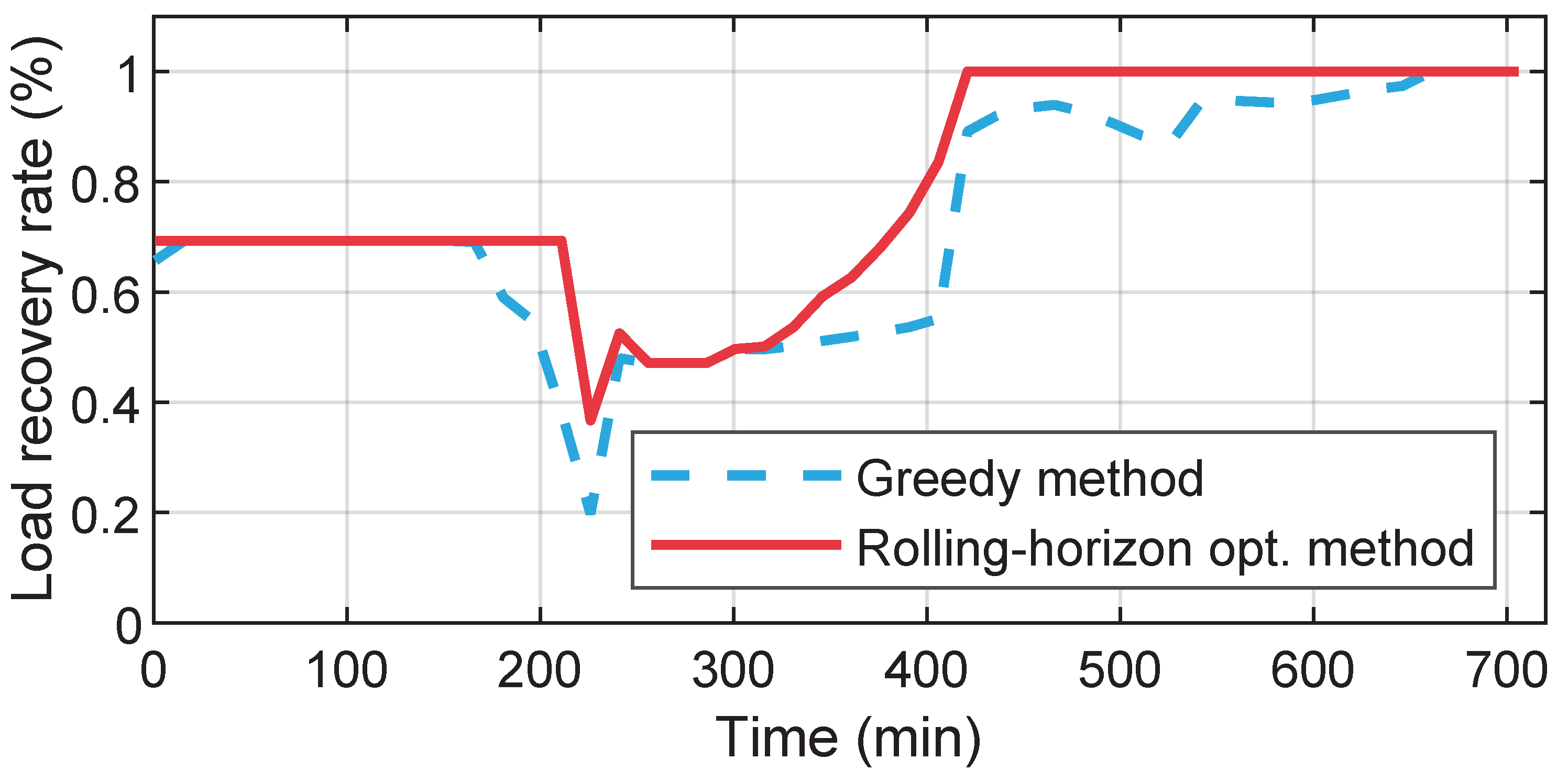
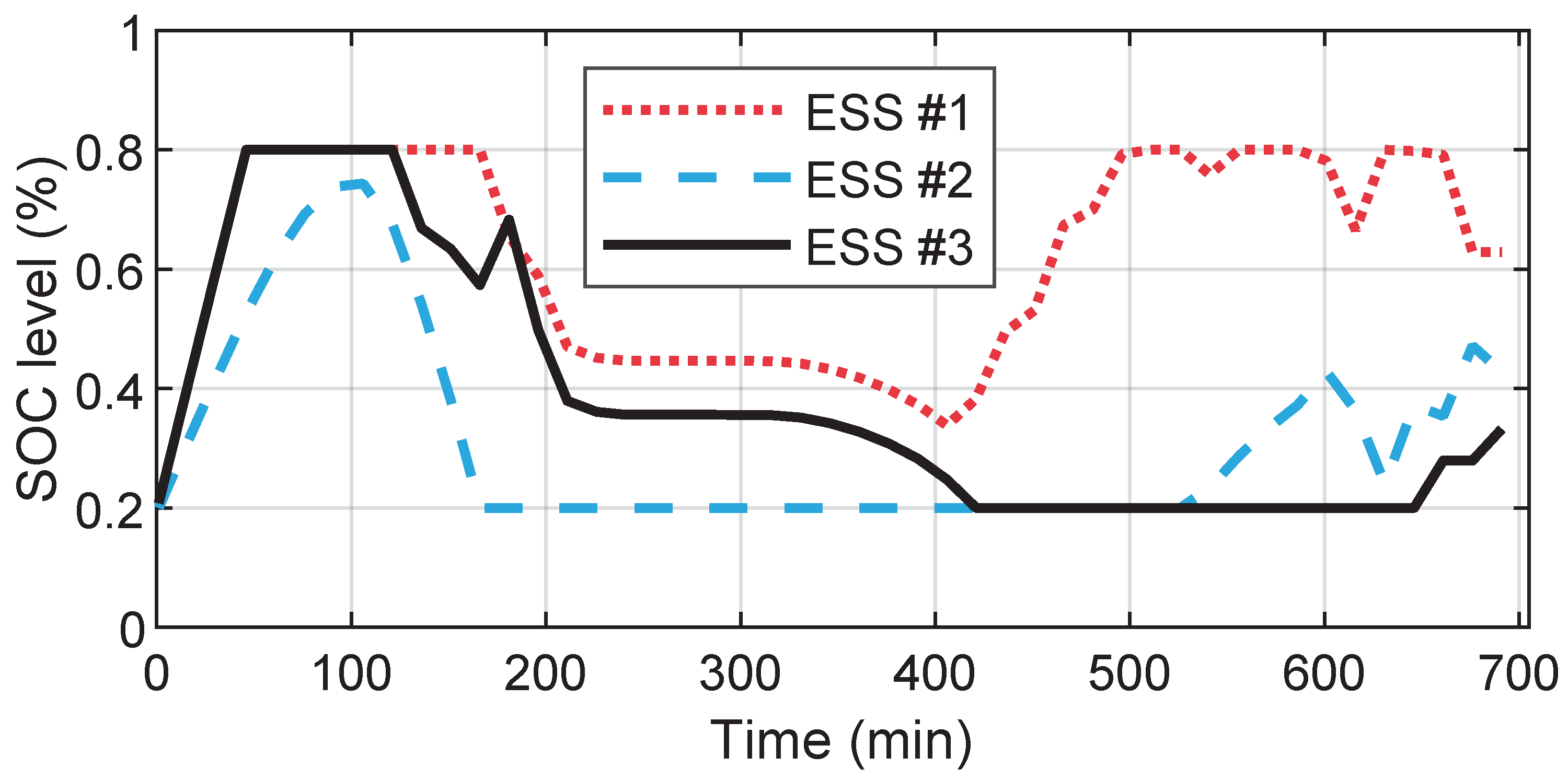
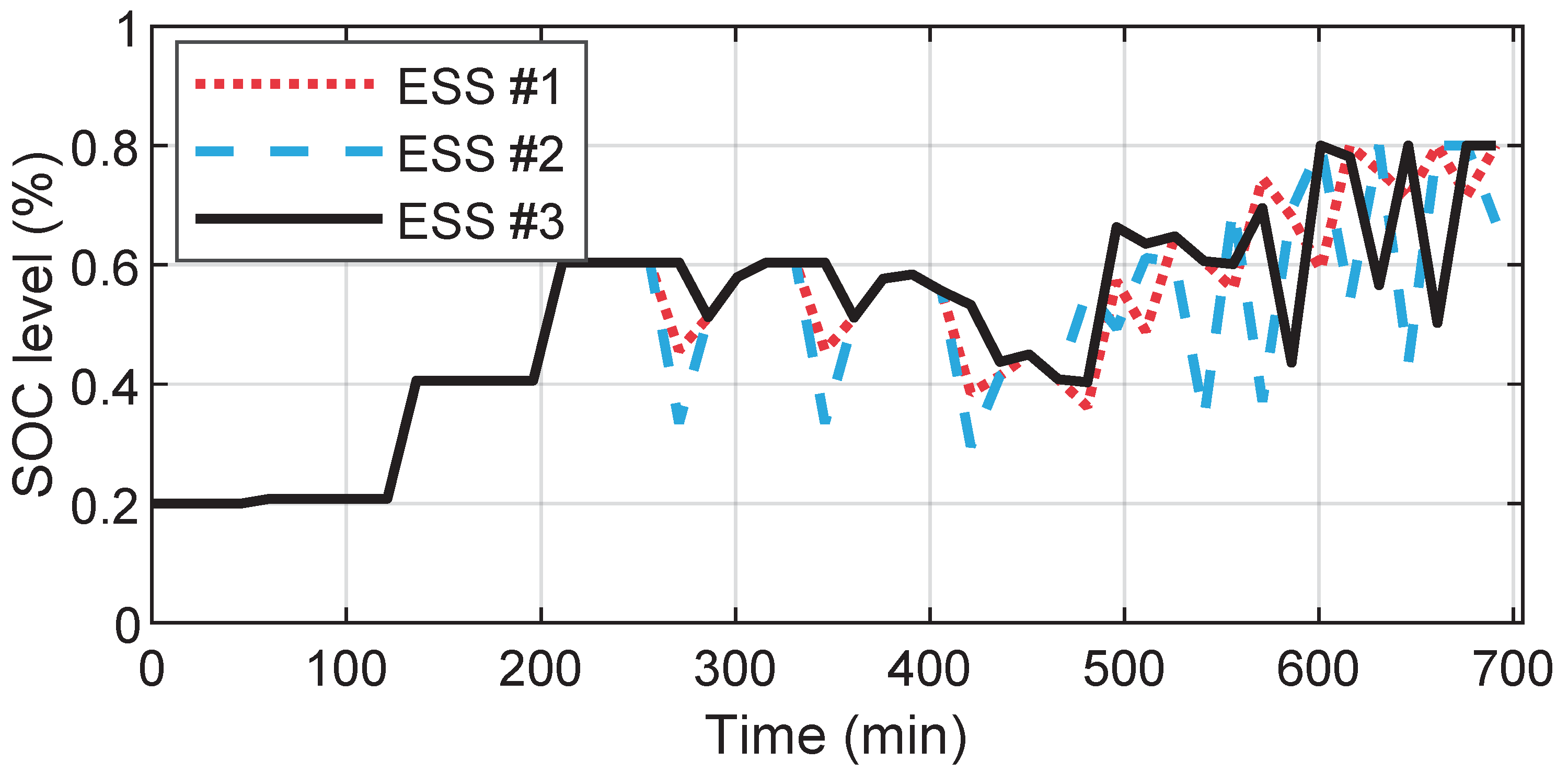
| Distribution Line | ||||||||
|---|---|---|---|---|---|---|---|---|
| Index | 23–24 | 19–20 | 9–15 | 6–7 | 6–26 | 9–10 | 12–13 | 29–30 |
| min | 240 | 300 | 360 | 420 | 480 | 540 | 600 | 660 |
Publisher’s Note: MDPI stays neutral with regard to jurisdictional claims in published maps and institutional affiliations. |
© 2022 by the authors. Licensee MDPI, Basel, Switzerland. This article is an open access article distributed under the terms and conditions of the Creative Commons Attribution (CC BY) license (https://creativecommons.org/licenses/by/4.0/).
Share and Cite
Xin, N.; Chen, L.; Ma, L.; Si, Y. A Rolling Horizon Optimization Framework for Resilient Restoration of Active Distribution Systems. Energies 2022, 15, 3096. https://doi.org/10.3390/en15093096
Xin N, Chen L, Ma L, Si Y. A Rolling Horizon Optimization Framework for Resilient Restoration of Active Distribution Systems. Energies. 2022; 15(9):3096. https://doi.org/10.3390/en15093096
Chicago/Turabian StyleXin, Ning, Laijun Chen, Linrui Ma, and Yang Si. 2022. "A Rolling Horizon Optimization Framework for Resilient Restoration of Active Distribution Systems" Energies 15, no. 9: 3096. https://doi.org/10.3390/en15093096
APA StyleXin, N., Chen, L., Ma, L., & Si, Y. (2022). A Rolling Horizon Optimization Framework for Resilient Restoration of Active Distribution Systems. Energies, 15(9), 3096. https://doi.org/10.3390/en15093096





